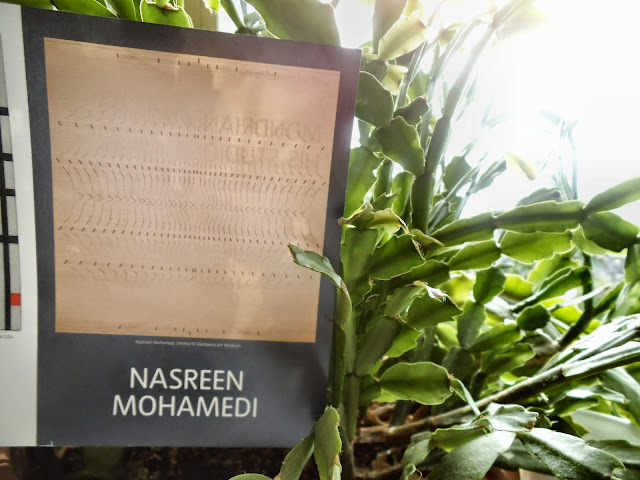
TV Accompanying Piet Mondrian on his journey through the Summer months at Tate Liverpool is Nasreen Mohamedi, the Indian artist who as we discovered in the press view tour but not through direct verbal comparison, shares certain biographical connections with the Dutch painter. As with the Constellations displays on other floors, this is an example of Tate Liverpool’s almost algorithmic approach to art, familiar to online shoppers. “If you like Piet Mondrian, who may also like … Nasreen Mohamedi …” And it works. Because I do.
Born in Karachi in 1937, raised in Mumbai, taught in London and Paris, Mohamedi created the majority of the work on display at Tate (the biggest collection of her work in the UK ever) when she returned to India, eventually settling in Baroda in the 1970s where she became a teacher at the Faculty of Fine Arts, MS University. She lived and worked there until her death in 1990 and its during this period that she shifted from nature into abstraction and her interest in trees, whose leaves and branches led to an intense study of triangles which became the dominant shape in her art.
The exhibitions shows her artistic transitions, beginning with almost Turner-like explorations of nature, gradations in colour indicating elements of the landscape to exploring grids to overt architectural shapes filled with perspectives and diagonals to floating forms, in which anything remotely figurative gives way to geometric shapes in the centre of stark, empty backgrounds to elliptical forms whose simplicity can be explained by a desperation to continue working despite a rare condition which affected her muscle control.
Throughout she was influenced by photography and the exhibition includes a selection of her own pictures as well as images of unclear provenance but which the artist has drawn lines and frames on to indicate abstract shapes hidden within. You can see the artist’s eye noticing that at a basic level the natural world and humanity’s degradation of it through buildings and vehicles can be incredibly similar. The curve of a river and a road at their most basic level contain the same internal geometry filled with triangles.
Mohamedi appears after Mondrian within the narrative body of the gallery space so it’s impossible not to view her work through the prism of the other artist. As the press notes say, “Mondrian, much like Mohamedi, moved away from a figurative style and developed his own unique approach to abstraction.” Both began with trees, but Mondrian ended up with squares, Mohamedi with triangles. Perhaps this is why Mondrian’s earlier work has been omitted. To include it would be repetitious or at least to prosaically spell out such connections.
There are some differences. With the exception of his London house, Mondrian’s life is heavily documented, even to the point of being able to tell which of his paintings were begun before the war then completed later. Mohamedi’s chronology is a blank. Most of these works are untitled and the only dates available are based on the recollections of friends and colleagues. In producing the exhibition, the curators have effectively had to guess that chronology with only a rough idea of when the artist shifted between her artistic periods.
Another approach might have been to mix the periods of the artists together ala Turner Monet Twombly, though Mohamedi and Mondrian are different enough that the resulting display would presumably have jarred rather than suggested clearer connections. In keeping the two artists separate and selling them as different shows within the same admission price, Tate suggest they stand alone, even if, Mohamedi can’t quite do that because the exhibition can’t be visited separately. Her entrance is at the end of Mondrian’s show and you have to exit through his gift shop.
Yet there’s no denying this is vintage Tate, in the spirit of Klimt and Chagall in which some of the best examples from a world renowned artist are brought together in the Liverpool and offered up to the visitor in a coherent, retrospective not to mention ballsy manner surrounded by plenty of wall and gallery space allowing them to breath, stand out, and challenging us to decide whether we do like it. This is Mondrian. This is what Mohamedi does. Iconic names. Iconic works. Come and see.
Nasreen Mohamedi is at Tate Liverpool from 6 June – 5 October 2014.
Adult £11 (without donation £10)
Concession £8.25 (without donation £7.50)
[Tickets for Mondrian and his Studios: Abstraction into the World include admission into Nasreen Mohamedi.]

No comments:
Post a Comment